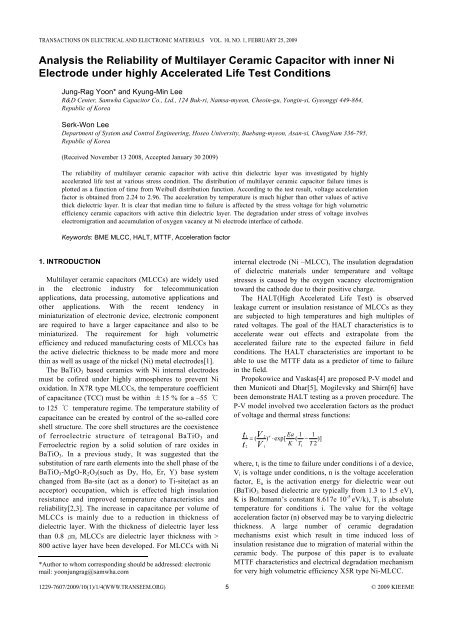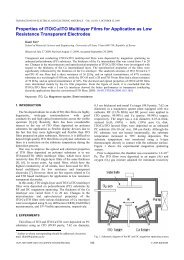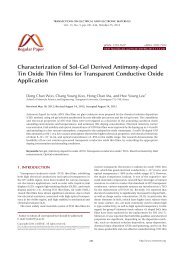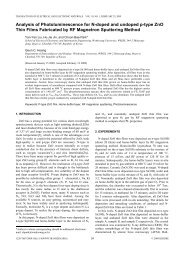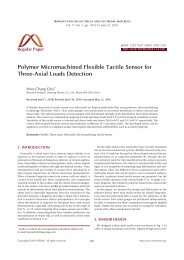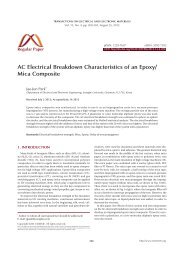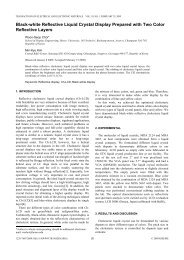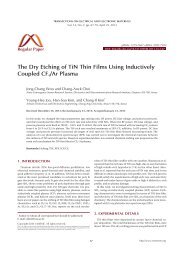Analysis the Reliability of Multilayer Ceramic Capacitor with inner Ni ...
Analysis the Reliability of Multilayer Ceramic Capacitor with inner Ni ...
Analysis the Reliability of Multilayer Ceramic Capacitor with inner Ni ...
You also want an ePaper? Increase the reach of your titles
YUMPU automatically turns print PDFs into web optimized ePapers that Google loves.
Trans. EEM 10(1) 5 (2009): J.-R. Yoon et al. 7Table 2. Summary <strong>of</strong> MTTF and m(shape parameter) under various stressconditions.Voltage 34 V 44 VTempMTTF(min)m(ShapeParameter)MTTF(min)m(ShapeParameter)125 ℃ 1596.78 - 894.43 2.076150 ℃ 610.8 1.988 338.19 2.382175 ℃ 306.1 2.117 142.53 3.219ttVV(1 2 n= ( ) ⋅22 1T2−θT1)A voltage stress exponent, n, was 2.24 ~2.96 andtemperature stress Θwas 17.08 ~ 20.05. n value <strong>of</strong> 2.24 ~2.96 is similar to accepted in <strong>the</strong> industry <strong>of</strong> ceramiccapacitor. However, temperature exponential (Θ) is higherthan any o<strong>the</strong>r values reported earlier[7]. It is clear that Θis significantly affected by <strong>the</strong> thickness <strong>of</strong> active layer .Figure 3 shows <strong>the</strong> MTTF predictions for applied voltageand temperature. The relation between <strong>the</strong> logarithm <strong>of</strong> <strong>the</strong>life time reciprocal <strong>of</strong> temperature showed linearity ascharacteristic <strong>of</strong> Arrhenius-type. Raising <strong>the</strong> test voltage hassignificantly decrease <strong>the</strong> predicted MTTF as Arrheniustypeformula, because <strong>the</strong> migration <strong>of</strong> ions and o<strong>the</strong>rdefects upon a chemical defect reaction.1000000Table 3. Individual voltage exponential (n) and temperature exponential(Θ) for each stress condition.n(34 V ~ 44 V)2.24 (125 ℃)2.29 (150 ℃)2.96 (175 ℃)θ (34 V) θ (44 V)18.03(125 ~ 150 ℃)25.05(150 ~ 175 ℃)17.08(125 ~ 150 ℃)20.05(150 ~ 175 ℃)100000100001000100101000001000020406080 100Temp(℃)(a)120140160180Figure 4 shows degradation model <strong>of</strong> MLCC <strong>with</strong> thinactive layer. When a strong electric field applied to activelayer, a tunnel current flows (Fowler-Nordheim electrontunneling). For <strong>the</strong> insulation resistance degradationbehavior <strong>with</strong> thin active layer, it was found that <strong>the</strong>tunneling current through grain boundary was dominant atinitial stage <strong>of</strong> a leakage current and <strong>the</strong>n oxygen vacanciesare present in significant amount in <strong>the</strong> core region, migratetowards <strong>the</strong> cathode[8]. The formation <strong>of</strong> electrical barriersis attributed to acceptor and doping <strong>of</strong> <strong>the</strong> n-type BaTiO 3dielectric and segregation <strong>of</strong> <strong>the</strong> dopants. In general, <strong>the</strong>large amount <strong>of</strong> oxygen vacancies in BaTiO 3 varies as afunction <strong>of</strong> <strong>the</strong> distance from <strong>the</strong> <strong>Ni</strong> electrode. Whenapplying dc field to <strong>the</strong> capacitor, oxygen vacancieselectromigrate from <strong>the</strong> anode to cathode. DC biasing leads to100010020406080100 120Temp(℃)140160180(b)Fig. 3. MTTF predictions for applied voltage and temperature.(a) Stress condition : 34 V, at 125, 150, 175 ℃(b) Stress condition : 44 V, at 125, 150, 175 ℃Table 3 indicated <strong>the</strong> importance <strong>of</strong> individual voltageexponential (n) and temperature exponential (Θ)for eachstress condition. The empirical MTTF equation for ceramiccapacitor by :Fig. 4. Tunneling schematic <strong>of</strong> <strong>the</strong> degradation model.
8 Trans. EEM 10(1) 5 (2009): J.-R. Yoon et al.chemical potential gradients and electromigration <strong>of</strong>charged defects. The concentration <strong>of</strong> oxygen vacanciesnear <strong>the</strong> cathode <strong>of</strong> <strong>Ni</strong> electrode is much higher than <strong>with</strong>in<strong>the</strong> dielectric layers, leading to local high conductivity. Theintrinsic defect <strong>of</strong> oxygen vacancies in BaTiO 3 are related tomaterial imperfections and cause <strong>the</strong> capacitors to fail in a<strong>the</strong>rmal runaway mode.4. CONCLUSIONThe reliability <strong>of</strong> MLCC <strong>with</strong> active dielectric layer wasinvestigated by HALT test:(1) The relation between <strong>the</strong> logarithm <strong>of</strong> <strong>the</strong> life timereciprocal <strong>of</strong> temperature showed linearity ascharacteristic <strong>of</strong> Arrhenius-type.(2) A voltage stress exponent was n=2.24 ~2.96 andtemperature stress was Θ=17.08 ~ 20.05. The value <strong>of</strong>n=2.24 ~ 2.96 is similar to accepted in <strong>the</strong> industry <strong>of</strong>ceramic capacitor.(3) The concentration <strong>of</strong> oxygen vacancies near <strong>the</strong> cathode<strong>of</strong> <strong>Ni</strong> electrode is much higher than <strong>with</strong>in <strong>the</strong> dielectriclayers, leading to local high conductivity.REFERENCES[1] H. Kishi, Y. Mizuno, and H. Chazono, Jpn.J.Appl.Phys. 42, 1 (2003).[2] A. Kirianov, T. Hagiwara, H. Kishi, and H. Ohsato, Jpn. J. Appl. Phys.41, 6934 (2002).[3] H. Kishi, N. Kohzu, Y. Mizuno, Y. Iguchi, J. Sugino, H. Ohsato, andT. Okuda, Jpn. J. Appl. Phys. 38, 5452 (1999).[4] T. I. Propokowice and A. R. Vaskas, ECOM Report No. 90705-F,(1969).[5] R. Municoti and P. Dhar, IEEE Trans. Comp., Hybrids, Manu. 11,346 (1988).[6] J. R. Yoon, B. C. Woo, H. Y. Lee, and S. W. Lee, J. <strong>of</strong> KIEEME(inKorean) 20, 118 (2007).[7] M. S. Randall, A. S. Gurav, D. J.Skamser, and J. J. Beeson, CARTS2003, p. 134.[8] G. Y. Yang, G. D. Lian, E. C. Dickey, C. A. Randall, D. E. Barber, P.Pinceloup, M. A. Henderson, R. A. Hill, J. J. Beeson, and D. J.Skamser, Jpn. J. Appl. Phys. 96, 7500 (2004).


